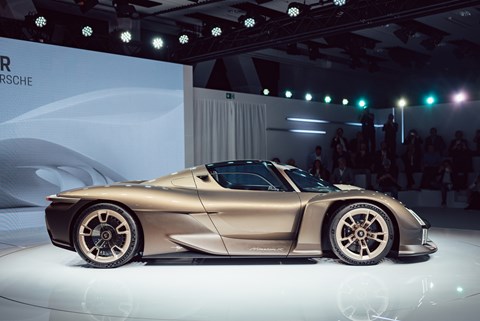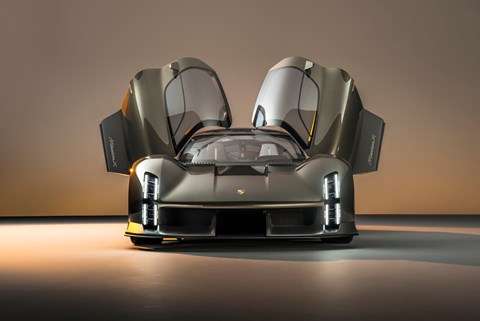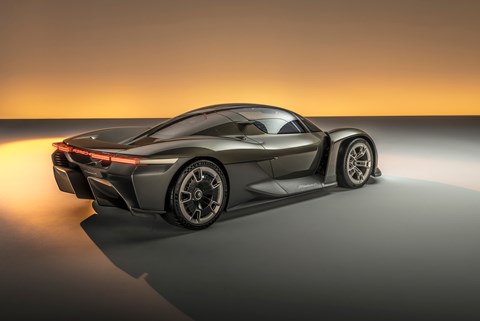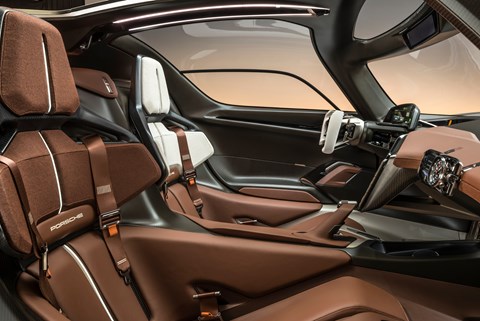► Mission X concept car revealed
► Porsche is eyeing a new ‘Ring record
► EV hypercar could make production
True surprises are rare in the car business, but Porsche just sprung one – a pure electric hypercar to celebrate its 75th birthday, complement its current Le Mans campaign and pick up where the 959, Carrera GT and 918 Spyder left off.
Called Mission X, the new car debuts this evening in concept form, but Porsche has already defined its targets ‘should we take our concept car into series production’.
The first is to create the fastest road-legal car on the Nürburging Nordschleife, which means it must go below the 6min 30.70sec achieved by the Mercedes-AMG One on the 20.6km lap
Secondly, Porsche is targeting a power-to-weight ratio of one PS (metric horsepower) per kg. There’s no word on a target weight to de-code that, but given production rivals like the Lotus Evija (1680kg/2000PS) and Rimac Nevera’s stats (2300kg/1900PS), we should be looking at an output of at least 1700bhp, perhaps substantially more – though we’d also expect Porsche to trim the fat wherever possible.

The number of e-motors and driven axles is not officially confirmed but electric motors driving both axles seems a given. Interestingly, the steering wheel does have paddles as well as mode buttons – the paddles could be for re-gen, but Porsche equips its Taycan with a two-speed transmission, so some element of driver control over the transmission is not inconceivable.
Porsche’s third target for the Mission X is to produce significantly more downforce than a 992 GT3 RS’s, which means more than that car’s massive 860kg.
Finally, charge times should be roughly twice as fast as the Taycan Turbo S thanks to a new 900V charging architecture (the Taycan boasts 800V and can charge at 270kW max). The battery sits behind the seats to mimic mid-engined weight distribution, though no word yet on its chemistry or size.
At around 4.5 metres long, two metres wide and with a wheelbase of 2.73 metres, the two-seat Mission X has comparable dimensions to its Carrera GT and 918 Spyder forbears.
Finished in Rocket Metallic with elements in a carbon-weave finish below the beltline, the body favours elegantly curved lines and muscle tone over outright aggression, and flows from vertical LED headlights set low in the nose and inspired by the 906 and 908 classic Le Mans racers.

Using a reinterpretation of Porsche’s four-point LED light graphic, the lights ‘blink’ open when the LED modules are activated. At the rear, a full-length light bar stretches across the Mission X and there’s illuminated Porsche lettering, complete with an ‘E’ that pulsates during charging.
Porsche says that 20-inch front and 21-inch rear tyres have been fitted for ‘aerodynamic purposes’ – the rears with near-transparent aeroblades for enhanced cooling (presumably meaning the harder working fronts are also cooled by ducting feeding in from elsewhere)

Passengers sit under a lightweight glass dome with a carbonfibre-reinforced plastic exoskeleton that stands 1.2 metres from the floor. Doors attached to the A-pillar and roof open upwards and forwards, inspired by Porsche’s 917 Le Mans winner of 1970 and ’71.
An asymmetric interior design stresses both the Mission X’s driver focus and its luxurious brief, with the CFRP-shelled driver’s seat, centre console and dashboard upholstered in Kalahari Grey and the passenger side (another CFRP shell) trimmed in contrasting Andalusia Brown.

‘The Porsche Mission X is a technology beacon for the sports car of the future. It picks up the torch of iconic sports cars of decades past: like the 959, the Carrera GT and the 918 Spyder before it, the Mission X provides critical impetus for the evolutionary development of future vehicle concepts,” says Oliver Blume, Chairman of the Executive Board of Porsche AG. “Daring to dream and dream cars are two sides of the same coin for us: Porsche has only remained Porsche by constantly changing.’
The bar is already set high, and not only in terms of Porsche’s supercar pedigree – the Stuttgart maker showed the Taycan in concept guise as the Mission E, and the production car remains the best-driving EV by a margin. If the Mission X does make production, let’s hope it can pull off a similar feat.